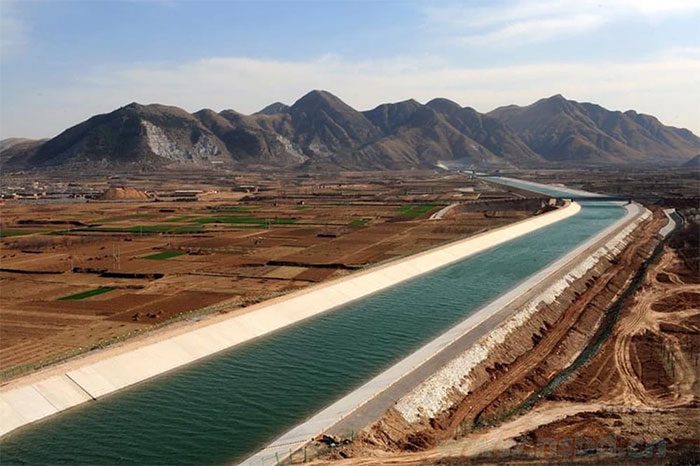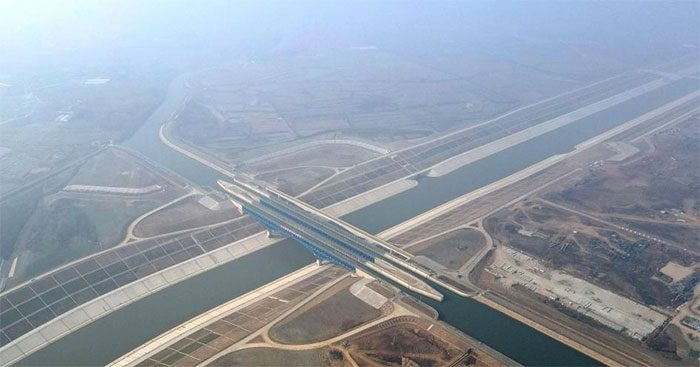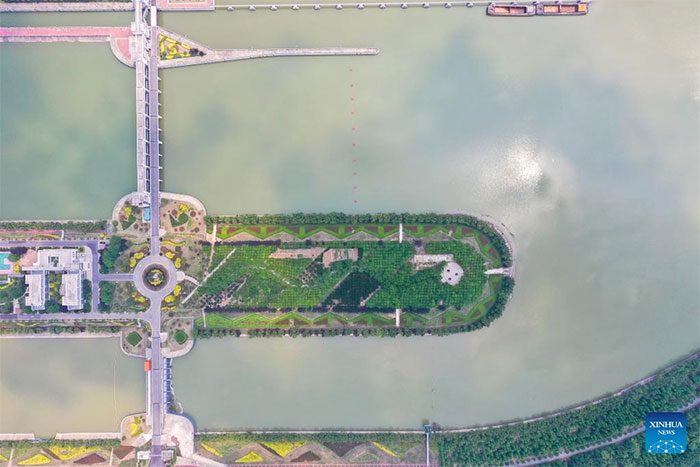This mega project has cost China tens of billions of USD.
Running through the northern regions of China is a unique “artificial river”, measuring 1,432 km (mainline), delivering clear and sweet water to the capital city of Beijing.
The journey of the water begins in a remote hilly area in central China at the Danjiangkou Reservoir. The water flows north through channels and pipes, crossing the Yellow River before arriving at Beijing’s water treatment plants 15 days later.
Two-thirds of the city’s tap water and one-third of the current total water supply come from Danjiangkou.
During the winter and spring of 2018, the reservoir was the “lifeblood” of Beijing. Despite experiencing the longest recorded drought, the city did not suffer any interruptions in its water supply. This was thanks to the South-to-North Water Diversion Project (SNWDP) of the nation.
China’s Expensive Mega Project: From the 1950s to 2050
The South-to-North Water Diversion Project (SNWDP) – an ambitious engineering project aimed at transferring surplus water from the Yangtze River to the arid Yellow River basin in the North – is considered the largest, most expensive, and most challenging water diversion project ever undertaken globally.
The monumental South-to-North Water Diversion Project began to take shape in the 1950s and, when fully completed by 2050, will transport tens of billions of cubic meters of water annually to residential centers in the north.
The project is expected to cost tens of billions of USD, possibly more than twice the cost of China’s largest mega infrastructure, the Three Gorges Dam. This dam, built over 12 years (1994-2006), cost approximately 28.6 billion USD, according to CNN.
In addition to providing water for the populace and enhancing shipping routes, the SNWDP is also utilized for agricultural irrigation and improving ecological environments.

Water from the Yangtze River finally reached Beijing in December 2014 when the central line of the South-to-North Water Diversion Project was put into operation. (Photo: Thethirdpole).
Reuters commented in an article published in June 2023 that as droughts emerged, China is planning new ambitious water infrastructure projects, hoping that moving more precious liquid across the country will mitigate the impacts of climate change.
Supporting this, Reuters reported that at the end of May 2023, Chinese officials announced plans to construct a “national water network” comprising new channels, reservoirs, and storage facilities that they believe will enhance irrigation and reduce flood and drought risks.
Li Guoying, China’s Minister of Water Resources, stated that this plan will “unclog the main arteries” of the river system by 2035, enhancing the state’s capacity for equitable water distribution.
Analysts noted that total investment in fixed water assets exceeded 1.1 trillion yuan (154 billion USD) in 2022, marking a 44% increase compared to 2021. Investment continued to rise by 15.6% to 407 billion yuan in the first quarter of 2023. Officials indicated that even more funding sources will be available.
A part of the new plan involves continuing the South-to-North Water Diversion Project (SNWDP) – completing the construction of the western route.

This aerial photo of the water diversion channel from the South-to-North Water Diversion Project was taken on December 30, 2022, in eastern China. (Photo: Liu Junxi/Xinhua).
Northern China has long been a center for population, industry, and agriculture. With its rapid development, the region’s limited water resources will certainly continue to dwindle.
Historically, this has led to the over-extraction of groundwater, which often supports urban and industrial development but harms agriculture, resulting in severe water shortages in rural areas. Additionally, land subsidence and frequent sandstorms in the region are also linked to overuse of groundwater.
Former Chairman Mao Zedong first proposed the idea of the diversion project in 1952. On August 23, 2002 – 50 years later – after extensive study, planning, and discussion, the South-to-North Water Diversion Project was approved by the State Council, and work began on the eastern route of the project in December of that year. Construction of the central route also started a year later.
The “Lifeblood” of the South-to-North Water Diversion Project
The South-to-North Water Diversion Project comprises three main water transfer lines: the central line, the eastern line, and the western line.
The most prominent of the three lines, due to its role in delivering water to the capital Beijing, the initial phase of the central line began supplying water to the area in December 2014.
The first phase of the eastern line, serving Jiangsu and Shandong provinces, became operational in November 2013.
Xinhua cited a statement from the China South-to-North Water Diversion Company in May 2023, stating that the eastern and central lines of the South-to-North Water Diversion Project have benefited over 150 million people. The project has transferred 62 billion cubic meters of water to the frequently drought-stricken north through the eastern and central lines.

This aerial photo taken on May 12, 2023, shows a pumping station of the South-to-North Water Diversion Project in Sihong County, Jiangsu Province, eastern China. (Photo: Fang Dongxu/Xinhua).

The eastern and central lines of the South-to-North Water Diversion Project have benefited over 150 million people. (Photo: Fang Dongxu/Xinhua).
The western line is still in the planning stage and has not yet been constructed. According to the Yellow River Conservation Commission, the first survey of this line was conducted in 1952.
According to the China South-to-North Water Diversion Cooperation Agency, the western line is a vital part of the national water network and a significant strategic measure to promote environmental protection and high-quality development in the Yellow River basin.
This is also a fundamental solution to address water shortages in the middle and upper reaches of the Yellow River, with immense significance for water security, economy, energy, food, and ecology.
The Eastern Line
The eastern line diverts from a main branch of the Yangtze River, near Yangzhou City, with water flowing along existing rivers to the Wuyishan Mountains of Shandong before crossing the Yellow River through a tunnel and flowing to Tianjin.
The completed diversion will stretch just over 1,155 km and includes the construction of 23 pumping stations with an installed capacity of 453.7 MW just in the initial phase to supplement the seven existing stations, which will be renovated and upgraded.
The Central Line
Construction of the central line began in December 2003. This line has a total length of about 1,432 km.
The central line transfers water from the Danjiangkou Reservoir on the Han River through new channels near the western edge of the Haihe Plain to flow through Henan and Hebei provinces to Beijing.
The central line helps supply water to 24 major cities and over 200 districts; directly benefiting 85 million residents along the route, CGTN reported in July 2023.
The Western Line
Construction of the western route – which involves building on the Qinghai-Tibet Plateau – at elevations ranging from 3,000m to 5,000m above sea level – began in 2010. Completing the western line, Chinese engineers must overcome significant technical and climatic challenges.
Once completed in 2050, the project will divert 4 billion cubic meters of water from three branches of the Yangtze River across nearly 500 km through the Bayankala Mountains to northwestern China.
Like other major projects in China, such as the Three Gorges Dam, the diversion plan under the South-to-North Water Diversion Project has raised numerous environmental concerns, primarily related to loss of heritage, displacement of people, and destruction of grasslands.
Moreover, industrialization plans along the project routes pose a significant risk of severe pollution to the redirected water sources.
To help combat this threat, the Chinese government has allocated more than 80 million USD for Jiangdu, Huai’an, Suqian, and Chuzhou, in eastern Jiangsu Province, to build treatment facilities – although estimates indicate that the actual costs may exceed this figure by more than double.
Overall, around 260 projects have been implemented to reduce pollution and ensure that water in areas of the South-to-North Water Diversion Project meets minimum drinking standards.


















































